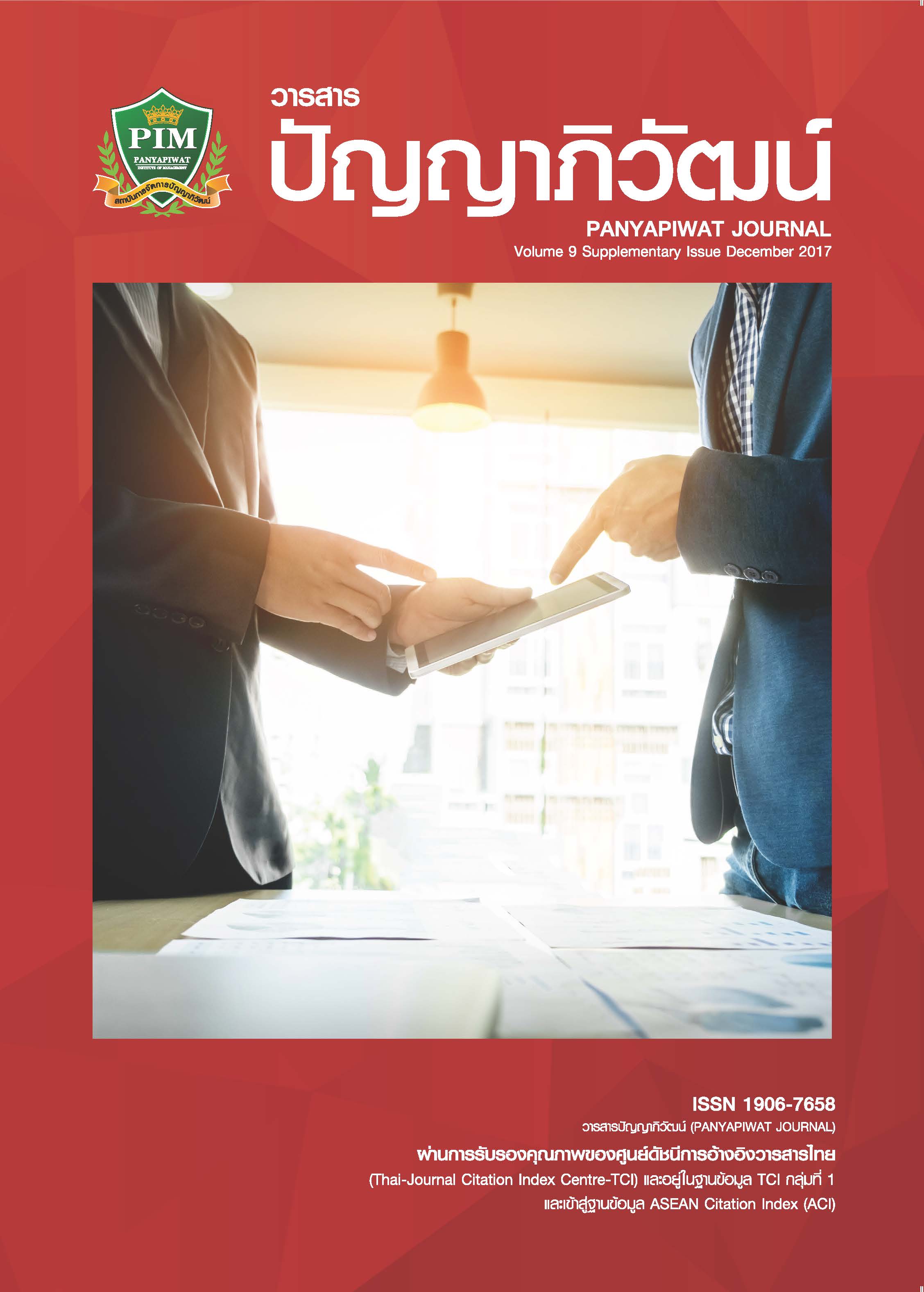SERVQUAL MODEL AND ANALYTIC HIERARCHY PROCESS ON THE EXPRESSWAY SERVICE QUALITY ASSESSMENT
Main Article Content
Abstract
Expressway is a common mean of transportation for Bangkok commuters due to the traffic congestion problem. Because of the higher toll rate on expressway, the service quality of the expressway, therefore, has received a greater emphasis. The identification of user satisfaction is important for improvement of the service quality of the expressway which is managed by the Expressway Authority of Thailand (EXAT). This study attempts to identify the service quality of the expressway and seeks for the most important service criteria. For that, the utilization of SERVQUAL approach with gap analysis model to compare expectation and perception on services are applied along with the Analytic Hierarchy Process (AHP) method to assess the weights of different service criteria. The results provide a better understanding about the expectation of expressway users and how to meet their satisfactions by minimizing the identified gap. In addition, the results provide suggestions on which service factors the EXAT needs to put greater emphasis on, in order to achieve the highest standard for expressway services.
ทางพิเศษแห่งประเทศไทย หรือทางด่วน เป็นเส้นทางหลักเส้นทางหนึ่งที่ผู้ใช้รถใช้ถนนในกรุงเทพมหานครและปริมณฑลเลือกใช้เพื่อหลีกเลี่ยงการจราจรที่ติดขัด แต่เนื่องจากทางด่วนมีการเรียกเก็บค่าบริการที่ค่อนข้างสูง ดังนั้น มาตรฐานการให้บริการที่ดีจึงเป็นสิ่งที่จำเป็น งานวิจัยนี้มุ่งเน้นที่จะพัฒนาแนวทางการวัดระดับความพึงพอใจของผู้ใช้บริการทางด่วน โดยใช้หลักการของแบบจำลอง SERVQUAL ที่จำแนกปัจจัยหลักในการวัดระดับความพึงพอใจของการให้บริการออกเป็น 5 ด้าน และยังสามารถใช้วัดช่องว่างระหว่างสิ่งที่ผู้ใช้บริการคาดหวังและสิ่งที่ได้รับได้อีกด้วย อย่างไรก็ดีปัญหาหนึ่งของ SERVQUAL ที่เห็นได้ชัดคือ การที่ SERVQUAL ให้น้ำหนักปัจจัยหลัก 5 ด้านที่ใช้วัดระดับความพึงพอใจในการให้บริการเท่าๆ กัน ดังนั้น งานวิจัยนี้จึงพยายามแก้ปัญหาดังกล่าว โดยนำวิธี Analytic Hierarchy Process (AHP) มาประเมินค่าความสำคัญที่แตกต่างกันของแต่ละปัจจัย โดยอาศัยความคิดเห็นจากกลุ่มผู้เชี่ยวชาญ ผลของงานวิจัยนี้จะช่วยให้การทางพิเศษแห่งประเทศไทยเข้าใจถึงปัญหาในการให้บริการขององค์กร ว่าควรต้องปรับปรุงการให้บริการในด้านใดเป็นหลัก และแบบจำลองนี้สามารถนำไปประยุกต์ใช้กับองค์กรที่ให้บริการอื่นๆ ในวงกว้างได้ต่อไป โดยนักวิจัยมีความเชื่อมั่นว่าการประยุกต์ใช้ AHP กับ SERVQUAL ร่วมกันจะทำให้ผลที่ได้รับแม่นยำกว่าการใช้ SERVQUAL เพียงอย่างเดียว
Article Details
I and co-author(s) certify that articles of this proposal had not yet been published and is not in the process of publication in journals or other published sources. I and co-author accept the rules of the manuscript consideration. Both agree that the editors have the right to consider and make recommendations to the appropriate source. With this rights offering articles that have been published to Panyapiwat Institute of Management. If there is a claim of copyright infringement on the part of the text or graphics that appear in the article. I and co-author(s) agree on sole responsibility.
References
Burapatana, T. & Ross, W. (2011). Improving the quality of life in Bangkok via change in city planning. Population and social studies, 20(1), 25-42.
Daugherty, P. J., Stank, T. P. & Ellinger, A. E. (1998). Leveraging Logistics/ Distribution Capabilities: The Impact of Logistics Service on Market Share. Business Logistics, 19(2), 35-51.
Department of Land Transport. (2013). Transport statistics report in 2013. Retrieved May 20, 2015, from https://apps.dlt.go.th/statistics_web/brochure/statreport113.pdf
Expressway Authority of Thailand (EXAT). (2013). Development of area in the express way boundary. Retrieved August 31, 2013, from https://www.exat.co.th/index.php/en_US/page/details/112
Innis, D. E. & La Londe, B. J. (1994). Customer Service: The Key to Customer Satisfaction, Customer Loyalty and Market Share. Journal of Business Logistics, 15(1), 1-27.
Lee, T. N., Fawcett, S. E. & Briscoe, J. (2002). Benchmarking the challenge to quality program implementation. Benchmarking: An International Journal, 9(4), 374-387.
Parasuraman, A., Berry, L. L. & Zeithaml, V. A. (1990). Guidelines for conducting service quality research. Marketing Research, December, 34-44.
Parasuraman, A., Zeithaml, V. A. & Berry, L. L. (1988). SERVQUAL: A multiple-item scale for measuring consumer perceptions of service quality. Journal of Retailing, 64(1), 12-37.
Parasuraman, A., Zeithaml, V. A. & Berry, L. L. (1985). A conceptual model of service quality and its implications for future research. Journal of Marketing, 49(4), 41-50.
Saaty, T. L. (1995). Decision making for leaders. Pittsburgh: RWS Publications.
Saaty, T. L. (1980). The Analytical Hierarchy Process. New York: McGraw-Hill.Stank, T. P., Goldsby, T. J., Vickery, S. K. & Savitskie, K. (2003). Logistics Service Performance: Estimating Its Influence on Market Share. Journal of Business Logistics, 24(1), 27-55.
Tanaboriboon, Y., Quium, A. S. M. A. & Changsingha, C. (1993). Performance indicator analysis: A management tool for the improvement of bus transit operation in Bangkok. Journal of Advanced Transportation, 27(2), 207-223.
The 24th International Foods & Drinks, Hotels, Bakery Exhibition. (2016). Retrieved Febraury 13, 2017, https://www.foodhotelthailand.com/food/2016/en/venue.asp
Vaidya, O. S. & Kumar, S. (2006). Analytic hierarchy process: An overview of applications. European Journal of Operational Research, 169(1), 1-29.
Yamane, T. (1967). Statistics: An introductory analysis (2nd ed.). New York: Harper and Row.
Zeithaml, V. A., Berry, L. L. & Parasuraman, A. (1996). The behavioral consequences of service quality. Journal of Marketing, 60(2), 31-46.


